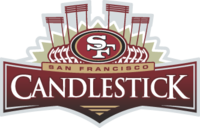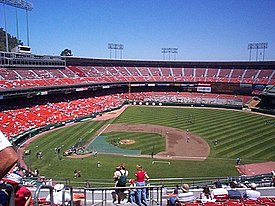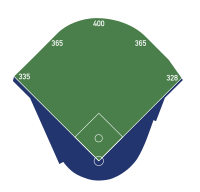
Back ملعب كانديلستيك بارك Arabic Candlestick Park Catalan Candlestick Park Czech Candlestick Park Danish Candlestick Park German Candlestick Park Spanish Candlestick Park Finnish Candlestick Park French कैन्डलस्टिक पार्क Hindi Candlestick Park ID
"The Stick" | |
   | |
 | |
| Former names | Harney Stadium (1956–1959) Candlestick Park (1960–1995, 2008–2013) 3Com Park at Candlestick Point (1995–2002) San Francisco Stadium at Candlestick Point (2002–2004) Monster Park (2004–2008) |
|---|---|
| Address | 602 Jamestown Avenue |
| Location | San Francisco, California |
| Coordinates | 37°42′49″N 122°23′10″W / 37.71361°N 122.38611°W |
| Public transit | |
| Owner | City and County of San Francisco |
| Operator | San Francisco Recreation & Parks Department |
| Capacity | 43,765 (1960) 63,000 (Baseball) 69,732[5] (Football) |
| Field size | Left field 330 ft (1960), 335 ft Left-center field & Right-center field 397 ft (1960), 365 ft[6] Center field 420 ft (1960), 400 ft Right field 330 ft (1960), 328 ft Backstop 73 ft (1960), 66 ft  |
| Surface | Bluegrass (1960–1969, 1979–2013) AstroTurf (1970–1978) |
| Construction | |
| Broke ground | August 12, 1958[1] |
| Opened | April 12, 1960 |
| Closed | August 14, 2014 |
| Demolished | February 4 – September 24, 2015 |
| Construction cost | US$15 million ($154 million in 2023 dollars[2]) |
| Architect | John Bolles & Associates |
| Structural engineer | Chin and Hensolt, Inc.[3] |
| General contractor | Charles Harney Co.[4] |
| Tenants | |
| San Francisco Giants (MLB) (1960–1999) San Francisco 49ers (NFL) (1971–2013) Oakland Raiders (AFL) (1960–1961) San Francisco Golden Gate Gales (USA) (1967) | |
Candlestick Park was an outdoor stadium on the West Coast of the United States, located in San Francisco's Hunters Point area. The stadium was originally the home of Major League Baseball's San Francisco Giants, who played there from 1960 until 1999, after which the Giants moved into Pacific Bell Park (since renamed Oracle Park) in 2000. It was also the home field of the San Francisco 49ers of the National Football League from 1971 through 2013. The 49ers moved to Levi's Stadium in Santa Clara for the 2014 season. The last event held at Candlestick was a concert by Paul McCartney in August 2014, and the demolition of the stadium was completed in September 2015. As of 2019, the site is planned to be redeveloped into office space.[7]
The stadium was situated at Candlestick Point on the western shore of San Francisco Bay. Candlestick Point was named for the "candlestick birds" (long-billed curlews) that populated the area for many years. Due to Candlestick Park's location next to the bay, strong winds often swirled down into the stadium, creating unusual playing conditions. At the time of its construction in the late 1950s, the stadium site was one of the few pieces of land available in the city that was suitable for a sports stadium, and had room for the 10,000 parking spaces that had been promised to the Giants.
The surface of the field for most of its existence was natural bluegrass, but for nine seasons, from 1970 to 1978, the stadium had artificial turf. A "sliding pit" configuration, with dirt cut-outs only around the bases, was installed in 1971, primarily to keep the dust down in the breezy conditions. Following the 1978 football season, the playing surface was restored to natural grass.
- ^ Rosenbaum, Art (August 12, 1958). "Bay City Banner". Los Angeles Times. Archived from the original on November 7, 2012. Retrieved September 16, 2011.
- ^ 1634–1699: McCusker, J. J. (1997). How Much Is That in Real Money? A Historical Price Index for Use as a Deflator of Money Values in the Economy of the United States: Addenda et Corrigenda (PDF). American Antiquarian Society. 1700–1799: McCusker, J. J. (1992). How Much Is That in Real Money? A Historical Price Index for Use as a Deflator of Money Values in the Economy of the United States (PDF). American Antiquarian Society. 1800–present: Federal Reserve Bank of Minneapolis. "Consumer Price Index (estimate) 1800–". Retrieved February 29, 2024.
- ^ "City and County of San Francisco, Candlestick Park, San Francisco, CA (1958–1960)". Pacific Coast Architecture Database. Retrieved September 9, 2016.
- ^ Munsey, Paul; Suppes, Cory. "Candlestick Park". Ballparks.com. Retrieved September 9, 2016.
- ^ "2009 San Francisco 49ers Media Guide" (PDF). Archived from the original (PDF) on March 4, 2016. Retrieved July 24, 2010.
- ^ "Candlestick Park dimensions cut". Spokane Daily Chronicle. Washington. Associated Press. December 15, 1960. p. 45.
- ^ Li, By Roland (March 12, 2019). "Mall plan dead at SF's Candlestick Point, former home of Giants and 49ers". San Francisco Chronicle.